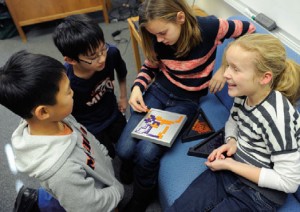Sorting out who you are takes time and effort.
Nicci King has her finger on the pulse of Middle School life, and she knows her students well. Nicci is Milton?s Middle School counselor. She began at Milton in 2005, and she responds to the needs of students, parents and colleagues as they try to understand adolescent behavior.
Nicci helped develop and co-teaches the 360? affective education class, a program that fosters empathy, respect and perseverance in our middle schoolers. It promotes the development of constructive communication, problem-solving and conflict-resolution skills. At the same time, it places great value on self-awareness and social responsibility. Nicci is a one-on-one counselor; she also provides day-to-day individual student assessment and crisis intervention.
In this article Nicci talks about the role of friendship in her students? lives.
Erin Hoodlet: What role does friendship play in the life of a middle schooler?
Nicci King: At this age, students are sorting out who they are through their relationships. They use friendship to try on different identities. Spending time with classmates who are into alternative, or pop, or country music is one way of trying on a different hat. This exploration is valuable for young people?it stokes different fires in them and helps them figure things out for themselves.
EH: Do you see the dynamics change from sixth to eighth grade?
NK: Sixth grade is a transition year, and those friendships may have more of a hierarchy of acceptance based on previous connections. Students are less willing to take social risks at that age, choosing instead to maintain familiar, comfortable connections. Students get past this as they get older.
In seventh grade students begin to branch out, but not all necessarily at the same time. Some students will stay with what?s familiar and some will want to stretch. Seventh graders are also starting to understand themselves and the world in a different way. Friendships begin to take the place of the parents? role.

Nicci King
Eighth graders are starting to pull back more from their parents, seeking more independence. They spend time with certain groups of friends when they?re feeling silly; they hang out with other groups when they?re feeling sophisticated. It?s nice for them to have a secure place within a distinct group, so they don?t feel pressure to be either silly or sophisticated. This social distinction can be the first real budding of identity through social connections.
Early in middle school, students are usually drawn to what?s familiar and what they know, so when they step beyond that comfort zone, it?s usually very purposeful. Around eighth grade, they make conscious decisions to explore, to take some social risks.
EH: Are the dynamics predictable?
NK: Teens are impulsive, and so are their moods. Their hormones have a natural fluctuation; thus, their likes, dislikes and emotions fluctuate daily. That?s reflected in their relationships. That?s also why their reactions, and investments in their relationships, can be so heightened.
As they begin to pull away from their parents, they can feel untethered, and they seek that grounded connection in their friendships. If a friend stops being supportive, or disagrees, or changes his mind about something, the student feels untethered, unsupported and insecure.
EH: How are girls and boys different, socially, at this age?
NK: Girls and boys are both going through a tumultuous time developmentally, and at this age they are often in different places in their social-emotional development. Generally, I see girls having more blatant and public emotional reactions than boys, and girls can appear more comfortable being emotionally expressive. Girls are actively invested in exploring and shaping each social connection at this age.
Boys tend to present as more ?stable? in their peer relationships. As adults, we may not see when a boy is upset or hurting. He might become quiet, sarcastic, act out behaviorally, or just play harder at sports. A herd mentality is often still present in middle school boys, and breaking from the pack to explore different social relationships can feel risky.
EH: What can adults do to help students navigate this landscape?
NK: Adolescents are so focused on the present and short-term future. What we see as an unmemorable bump in the road is hugely significant to them. It?s their reality. Often adults say, ?You won?t even remember this in a month,? but that?s not helpful, because it dismisses the strong emotional reaction the teen is having now. They live their lives so in the moment.
We want them to build resilience, problem-solving skills, confidence, and we can negate all of that by being dismissive.
Middle schoolers are looking for friendship, but they are also looking for adults other than their parents who can relate to them, validate them, know them, and look out for them.
 EH: What role do social media and electronic communication play at this age?
EH: What role do social media and electronic communication play at this age?
NK: One of the effects of electronic communication is that students realize this false freedom of expressing themselves without having to deal with the physical and emotional reactions of the people they?re communicating with. These mediums give kids license to say things that are really out of character for them. Again, they?re trying on different identities and testing limits?personal, social, societal. Social networking can take a negative turn very quickly. People are typically much more careful with how they express themselves when they?re faced with the burden of watching someone?s face crumble, or seeing the immediate effects their words have.
This dynamic makes friendship more challenging for adolescents today, but I also think the community students can connect with online can be valuable. On the one hand, the 24-hour accessibility of texting and email and Facebook broadens the reach of bullies, extending beyond the school day. On the other hand, adolescents have broader access to other people dealing with the same things they?re dealing with. They might realize that they?re not alone in something, and that other people are dealing with what they?re going through as well.
For better or worse, this generation is charged with sorting out electronic communication and how it affects us. It?s hard for parents, because they can?t exactly relate to the experience. I think we?re all learning as we go.
EH: What do middle schoolers depend on from their friends?
NK: At this age, girls and boys count on their friends to validate who they are. Friends fill a void that develops as the students are pulling away from their parents, seeking independence but still needing to lean on someone, something. Friends are their support, advice-givers, touchstones. In middle school, what your friends think tends to be far more important than what your parents think.
Middle schoolers want to be seen as individuals, as part of groups, sometimes by what they enjoy. They don?t know who they are exactly, and they change every day, but they?ll remind you of how they?re changing??You know I actually don?t like that (music group, book genre, academic subject, television show) anymore.?
Of course, the students will likely say that none of this is true. They don?t want to be defined.
Source: http://www.miltonmagazine.org/?p=658
sam young ncaa bracket ramon sessions portland trail blazers nba trade blagojevich new mexico state
No comments:
Post a Comment
Note: Only a member of this blog may post a comment.